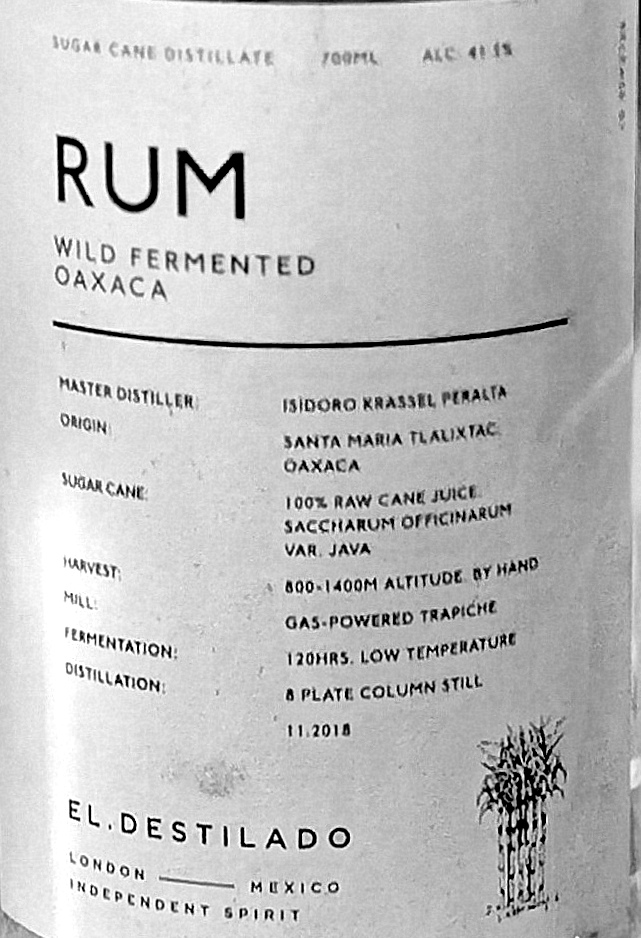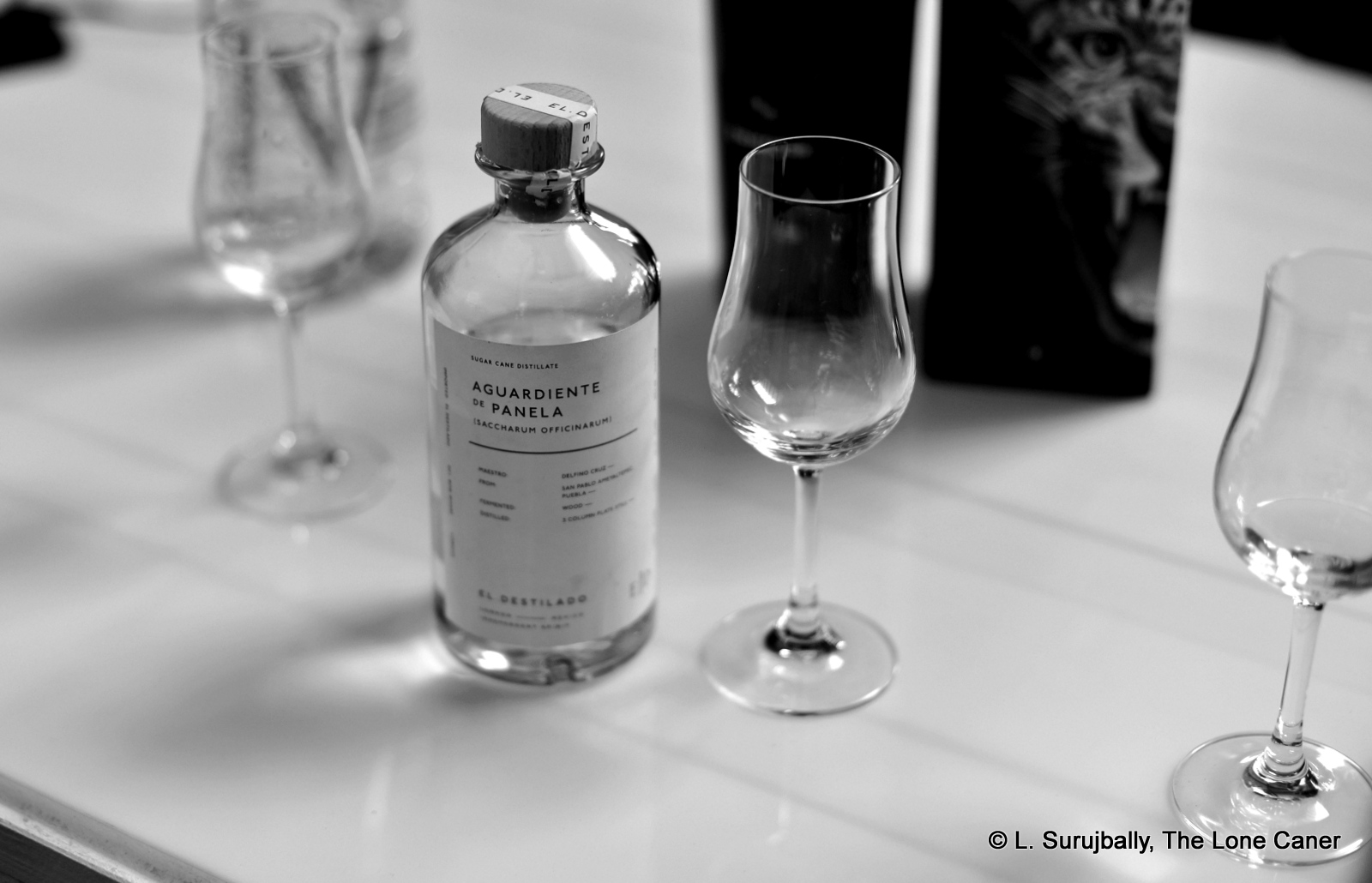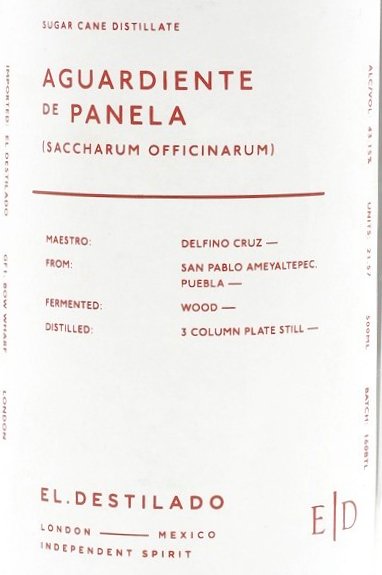Few even within the rum world and almost nobody outside it, will remember the small UK indie bottler El Destilado about which I and a couple of others wrote in our reviews of the fascinating, off-the-reservation Aguardiente de Panela, a rum from a tiny back-country distillery in Mexico. The three British guys who run El Destilado are unabashed agave lovers and dabble with rums only as a kind of sideshow; yet so enormous was the impact that that single limited edition artisanal rum made, that not only did I immediately try to buy all available rums which the little indie had released, but added the word panela to my vocabulary, started researching artisanal Mexican spirits like aguardientes and charandas, and marvelled yet again at the sheer diversity of sugar cane spirits.
This white unaged rum is another from the southern state of Oaxaca in Mexico, and originates in a small hill town of some three thousand inhabitants called Santa Maria Tlalixtac, which is remote enough not to have any highway coming anywhere near it; one wonders how on earth the guys even found the place, let alone the third generation distiller who makes it, Isidore Krassel Peralta1. As with the Aguardiente noted above, the rum shares some DNA with grogues, clairins, backwoods cachacas, kokuto shochus, arrack and charandas – which is to say it is made individually according to their own methods, and primarily for local consumption (see historical notes below) and with tastes blasting out in all directions.
Consider the production stats: the masterfully minimalist label states it derives from cane juice made from Java cane, itself grown on small fields at altitude, hand harvested, crushed with a gas-powered trapiche, fermented with naturally-occurring (“wild”) yeast for five days2 in seven 1200-liter stainless steel tanks, and then squeezed through an 8-plate steel column still which is of the founder’s own design and make dating back to the 1930s (it’s been tinkered with ever since), and which produces no heads or tails.
What comes out the other end and bottled for El Destilado is nothing short of amazing. There I was in the Black Parrot bar in London (with the itinerant Richard Nicholson, both of us making occasional sheep’s eyes at the helpful and very pretty bartender Marine who was pouring our flight of five and laughing at our seriousness), and when I took my first sniff of the white rum that is the subject of this review, so astounding was the initial nose that my first tremblingly written and near disbelieving comment was “Would you just smell that!!”
Aromas jetted and frothed out of the glass in all directions – nicely intense musky and tart white cane juice spiked with alcohol were the first; then plasticine and rubber and brine, extremely dry and very very clear, stopping itself from being blade-sharp and dangerous by a mere whisker. Pine needles, lemon juice, yoghurt, olives and dish washing soap clashed and banged together without apology with crisp green apples, grapes and gooseberries, to say nothing of iodine, florals and even a touch of grass and herbs. The low strength — 41.5%, should have mentioned this before — which I would occasionally see as a problem, actually helps here because it tames what would otherwise be a hurricane of rumstink and tones it down so it actually becomes quite good and really accessible.
The fun doesn’t stop there, and the palate takes the handoff neatly, then sprints ahead. It tastes dry, arid, minty, and reeks of alcoholic cane juice, like a mojito or a ti-punch but without the additional ingredients (no, really). There are tastes of watery sugar cane syrup, licorice, crushed mint, ripe apples, grapes and even green peas (!!), tart, briny, pine-y and smoky all at once. “It’s almost a mescal,” observed Richard sagely, his eyes crossed and his speech slurred (though it was only our first rum of the evening), as he tried masterfully not to upchuck his lunch of South Island orc flank. I concurred in principle, but honestly, you’d not mistake one for the other – this is a rum through and through and it concluded with a sort of rough, slouching grace: sharp, firm and gnarly, redolent of spearmint, sugar water, thyme, brine, half-ripe tart fruits and a bag of pepper-stuffed olives.
Man, that’s some experience, let me tell you, the more so because it does kind of come at you so unexpectedly, with all the in-your-face kinetic aggro of a 1970s Amitabh Bachchan movie. It’s a smorgasbord of smells and flavours that collapse together with a bang and the only real mystery is how a rum of a mere 41.5% can show off so much. Taken aback at first, I ended up with a completely positive opinion of the thing: because, at end, I truly felt that it was not some feeble attempt to copy nobler sires, but a celebration of gusto, of gumption, from a company unafraid to make bold gestures. Trust me, this is a rum from which you will not walk away unmoved. Unshaken you might be, but I can almost guarantee that you will be stirred.
(#998)(85/100) ⭐⭐⭐½
Historical background
The distillery of make doesn’t seem to have a name or a company title. It looks like it’s just called “Krassel’s” and they also make rum under their own brand of Cañada which is primarily marketed in the USA. If the name sounds vaguely Teutonic, that’s because it is: the paterfamilias left Germany just before the First World war and came to Veracruz in 1917. Working various odd jobs and constantly moving to where there was employment, he ended up in the Cañada region of Oaxaca, got married and assisted in small batch distillation on the distillery of the farm where he worked. After he gained sufficient expertise, he designed and built his own still and began distilling aguardiente on his own account in Santa Maria Tlalixtac, where he settled down.
That still is understandably famous, not the least because it continued to be tinkered with and improved upon as the years passed by Max’s three sons (Max Jr., Isidoro and one other). As the rum he produced improved in quality its reputation spread, but the lack of roads proved to be a hindrance to distribution and using mule pack trains to transport lots of 40-litre jugs was impractical. By the 1960s and beyond, the sons got pilot’s licences, bought a Cessna and used it to ferry their rum around the small surrounding communities for their fiestas and local shops. The third generation continued to be involved in the family enterprise, mostly Isidoro’s four sons.
It’s unclear when this happened — my guess is over the last decade ort so — but two American distributors now manage the rum brand’s importation into the USA, so its profile is definitely increasing there. El Destilado is, however, a UK company run by a trio of young enthusiasts and is separate from these; they do not mention the Cañada brand at all and distribute mostly in the UK and Europe.
Other notes
- The company website for Krassel’s is quite informative and is worth a read through
- Alex over at the The Rum Barrel Blog has reviewed the overproof version of this rum in 2021 and scored it 81/100 on his scale (about 86 on mine). Rum-X has two ratings, one of 7/10 and one of 8/10. Not much else out there
- Good background notes on aguardientes and Mexican rum culture can be found in the Panela review mentioned above.



